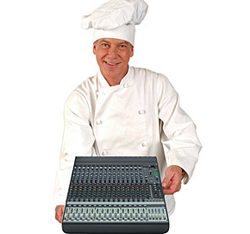
Begin with the pianist playing a selection. Then the guitarist should join after the first verse.
If the guitar can’t be heard clearly, it may be necessary to reposition the guitarist. If the guitar is still not loud enough, then a microphone might need to be added.
If drums are part of the performance, again begin with the piano playing, then guitar. After a minute or two, start the drummer. Listen first to determine if the piano and guitar can still be heard.
Hint: The higher octaves of the piano are usually easier to hear above other instruments.
If either lead instrument starts to get buried, try moving the drums further back on the platform and/or enclosing them with isolation panels. As a last resort, gradually increase the microphone level on the piano and guitar. Then, add any other acoustical instruments, including backing guitars, woodwinds and brass.
The third layer consists of electronic instruments such as keyboards, electronic guitars, bass guitars, acoustic instruments with electronic pickups, electronic drums, and so on.
Using the same procedure as before, begin with piano, and then add electronic keyboards to the mix. (By the way, the drummer and other acoustical players can take a break – they aren’t necessary at this particular point.)
Continue by adding other electronic instruments. When it’s at a satisfactory point, take a break of your own. Leave the room and enjoy five minutes of silence, then come back and evaluate the entire instrumental mix.
Last, but certainly not least, come the vocals. Begin with the background vocals, adding them one at a time, just as was done with instruments.
The topping is the primary vocalist(s), who must be heard and understood above all other aspects of the performance.
Keep in Mind
- Always listen for what is too loud as well as what is too soft.
- If a musician or vocalist expresses need to hear more monitor level, first try turning down other monitors (and instrument amps).
- Make level changes to the monitor mix or channel gain/trim control when the musician or vocalist is not active.
- Any changes should be small and gradual.
- Occasionally turn down the master levels for the main system and listen to the monitor system to evaluate its loudness – the monitors may be negatively impacting the main system.
- Regularly walk through the first few rows of seats to evaluate monitor versus main levels.
- If your church primarily features a rhythm band, drums and bass form the layer above the ambient noise, followed by rhythm guitar(s) and keyboards, then lead guitar and other lead instruments, with vocals on top.
- Become familiar with every song – for example, understand that lead guitar may need to jump to the top layer during an instrumental break, and don’t let this come as a surprise!
Travis Ludwig is a faculty member of the Internet Sound Institute.
